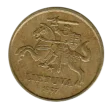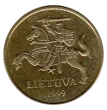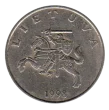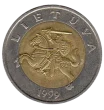Exchange your Lithuanian Litu
Do you have leftover Lithuanian Litu? We offer a fast and easy way to exchange both current and withdrawn Lithuanian Litu banknotes and coins. Convert them into your local currency today with our quick and hassle-free exchange service.
Lt - LTL
The Lithuanian Litas was replaced by the Euro in 2015, marking Lithuania’s full integration into the Eurozone.
Lithuanian Litu Information
The Lithuanian Litas (LTL) was the official currency of Lithuania from 1922 until 2015, when it was replaced by the Euro. The Litas was introduced following Lithuania’s declaration of independence after World War I. It became a symbol of the country’s national sovereignty and independence. However, like other Baltic states, Lithuania was occupied by the Soviet Union during World War II, and the Soviet Ruble replaced the Litas as the currency during that period. The Litas was reintroduced in 1993 after Lithuania regained its independence, signaling a new era of economic autonomy.
The Lithuanian Litas was subdivided into 100 centai, and the currency was issued in both coins and banknotes. Coins were available in denominations ranging from 1 centas to 5 litas, while banknotes were issued in denominations of 10, 20, 50, 100, 200, and 500 litas. The designs on Litas banknotes often featured important national symbols, historical figures, and landmarks that represented Lithuania’s rich cultural and political history. These images included depictions of famous Lithuanian leaders, historical landmarks, and cultural symbols, such as the national coat of arms, known as Vytis.
The stability of the Lithuanian Litas played a significant role in supporting the country’s economic recovery following the collapse of the Soviet Union. As Lithuania transitioned from a centrally planned economy to a market economy, the Litas helped to establish financial stability and build investor confidence. The Litas was initially pegged to the U.S. Dollar and later to the Euro, which ensured its stability in international markets. This stability was crucial for Lithuania’s economic growth, particularly during the 1990s and early 2000s as the country implemented significant economic reforms.
In 2004, Lithuania became a member of the European Union, and the eventual adoption of the Euro became part of the country’s long-term economic goals. On January 1, 2015, Lithuania officially adopted the Euro, replacing the Litas at a fixed exchange rate of 1 Euro to 3.4528 Litas. The transition to the Euro was seen as a key milestone in Lithuania’s integration into the European single market and its participation in the Eurozone. The adoption of the Euro provided Lithuania with greater economic stability and deeper access to European financial markets.
Despite the transition to the Euro, the Lithuanian Litas continues to hold sentimental and historical value for many Lithuanians. Litas banknotes and coins are now prized by collectors, and the currency remains a symbol of Lithuania’s resilience and determination to regain its independence and establish itself as a modern European nation. For many, the Litas represents a period of national pride and growth as Lithuania overcame the challenges of the post-Soviet era.
In conclusion, the Lithuanian Litas was the official currency of Lithuania for several decades and played a central role in the country’s economic transformation. It was replaced by the Euro in 2015, but it continues to hold historical significance as a symbol of Lithuania’s independence and national identity.















